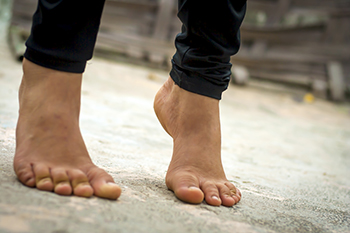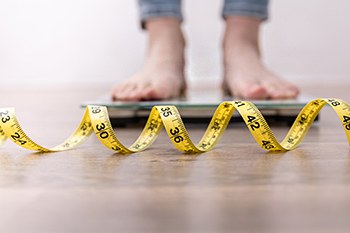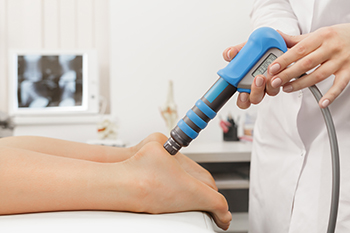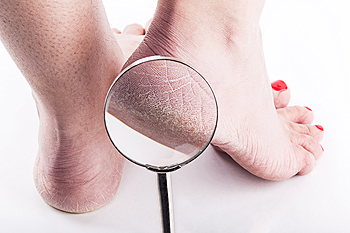Connect With Us
Blog
Items filtered by date: August 2022
The Feet Absorb and Control Impact During Running

There are several phases that the feet go through while running. The heel strike is sometimes referred to as ground contact and this happens when the foot lands on the ground. This is followed by rolling up to the forefoot and ends by pushing off. One of the responsibilities the feet have is to absorb and control the impact as walking and running take place. The term pronation is the inward movement the foot makes, and it is slightly lifted off the ground when running. When the foot strikes the ground, a normal foot structure will pronate to cushion the landing. This is followed by the arch as it lifts from its flattened state and will generally become stiff to maintain stability. Many runners have overpronation which may be common among people who have flat feet. The running shoes will often show evidence of overpronation and may show wear and tear on the inside part of the heel. If you would like to know more information about foot structure or biomechanics of the feet, feel free to consult with a podiatrist who can answer any questions you may have.
If you have any concerns about your feet, contact one of our podiatrists from Foot and Ankle Center. Our doctors can provide the care you need to keep you pain-free and on your feet.
Biomechanics in Podiatry
Podiatric biomechanics is a particular sector of specialty podiatry with licensed practitioners who are trained to diagnose and treat conditions affecting the foot, ankle and lower leg. Biomechanics deals with the forces that act against the body, causing an interference with the biological structures. It focuses on the movement of the ankle, the foot and the forces that interact with them.
A History of Biomechanics
- Biomechanics dates back to the BC era in Egypt where evidence of professional foot care has been recorded.
- In 1974, biomechanics gained a higher profile from the studies of Merton Root, who claimed that by changing or controlling the forces between the ankle and the foot, corrections or conditions could be implemented to gain strength and coordination in the area.
Modern technological improvements are based on past theories and therapeutic processes that provide a better understanding of podiatric concepts for biomechanics. Computers can provide accurate information about the forces and patterns of the feet and lower legs.
Understanding biomechanics of the feet can help improve and eliminate pain, stopping further stress to the foot.
If you have any questions please feel free to contact our office located in Egg Harbor Township, NJ . We offer the newest diagnostic and treatment technologies for all your foot and ankle needs.
Several Reasons Why Cuboid Syndrome May Develop

People who experience pain on the outside of the foot may have cuboid syndrome. This foot condition can follow an ankle sprain and may be difficult to diagnose. It can be common among ballet dancers and can result due to the style of dance they perform. The cuboid bone is one of seven tarsal bones and lies beneath the fourth and fifth toes. If this becomes moved from gradual overuse or an injury, it may become inflamed, referred to as cuboid syndrome. Additional causes of developing cuboid syndrome can include training on uneven surfaces, lack of adequate support from wearing the wrong shoes, or possibly excessive pronation. Some people have intermittent pain and there can be tenderness along the outside of the foot which may be similar to having an ankle injury. There are various treatment options for this condition and it is strongly advised that you are under the care of a podiatrist who can determine the best course of treatment for you.
Cuboid syndrome, also known as cuboid subluxation, occurs when the joints and ligaments near the cuboid bone in the foot become torn. If you have cuboid syndrome, consult with one of our podiatrists from Foot and Ankle Center. Our doctors will assess your condition and provide you with quality foot and ankle treatment.
Cuboid syndrome is a common cause of lateral foot pain, which is pain on the outside of the foot. The condition may happen suddenly due to an ankle sprain, or it may develop slowly overtime from repetitive tension through the bone and surrounding structures.
Causes
The most common causes of cuboid syndrome include:
- Injury – The most common cause of this ailment is an ankle sprain.
- Repetitive Strain – Tension placed through the peroneus longus muscle from repetitive activities such as jumping and running may cause excessive traction on the bone causing it to sublux.
- Altered Foot Biomechanics – Most people suffering from cuboid subluxation have flat feet.
Symptoms
A common symptom of cuboid syndrome is pain along the outside of the foot which can be felt in the ankle and toes. This pain may create walking difficulties and may cause those with the condition to walk with a limp.
Diagnosis
Diagnosis of cuboid syndrome is often difficult, and it is often misdiagnosed. X-rays, MRIs and CT scans often fail to properly show the cuboid subluxation. Although there isn’t a specific test used to diagnose cuboid syndrome, your podiatrist will usually check if pain is felt while pressing firmly on the cuboid bone of your foot.
Treatment
Just as the range of causes varies widely, so do treatments. Some more common treatments are ice therapy, rest, exercise, taping, and orthotics.
If you have any questions, please feel free to contact our office located in Egg Harbor Township, NJ . We offer the newest diagnostic and treatment technologies for all your foot care needs.
Do Your Child's Feet Hurt?
Extra Weight May Equal Foot Pain

If you are obese, which is classified as having a body mass index (BMI) of 30 or higher, you may be putting undue stress on your feet and ankles. Studies show that obese individuals are more likely to have foot pain than those who are not obese. Some conditions that obesity may contribute to include flat feet, plantar fasciitis and other heel pain, hammertoes, and bunions. Also, being obese can increase your chances of having certain diseases that can negatively impact your feet such as gout and diabetes. Aside from trying to lose weight, you can relieve pain and reduce the negative effects of obesity on your feet by choosing better footwear and using custom orthotics in your shoes. Custom orthotics can help to relieve pressure points, support your arch, and distribute your body weight more evenly across your feet. A podiatrist can help you with these proactive measures as well as treat any painful conditions that excess weight may have caused in your feet.
Obesity has become very problematic at this point in time and can have extremely negative effects on the feet. If you’re an obese individual and are concerned about your feet, contact one of our podiatrists from Foot and Ankle Center. Our doctors can provide the care you need to keep you pain-free and on your feet.
Obesity and Your Feet
Since your feet are what support your entire weight when standing, any additional weight can result in pain and swelling. Being overweight is one of the main contributors to foot complications.
Problems & Complications
Extra Weight – Even putting on just a few extra pounds could create serious complications for your feet. As your weight increases, your balance and body will shift, creating new stresses on your feet. This uneven weight distribution can cause pain, even while doing the simplest tasks, such as walking.
Diabetes – People who are overweight are at serious risk of developing type-2 diabetes, which has a drastic impact on the health of your feet. As you get older, your diabetes might worsen, which could lead to loss of feeling in your feet, sores, and bruises. You could also become more prone to various infections.
Plantar fasciitis – Pressure and stress that is placed on muscles, joints, and tendons can trigger plantar fasciitis, which is an inflammation of tissue that forms along the bottom of the foot.
If you have any questions please feel free to contact our office located in Egg Harbor Township, NJ . We offer the newest diagnostic and treatment technologies for all your foot and ankle needs.
Shockwave Therapy May Provide a Break From Heel Pain

Sound wave technology that is similar to Shockwave Lithotripsy—which has been used to break up kidney stones for decades—can also be very effective in treating plantar fasciitis. Plantar fasciitis is a painful inflammation of the plantar fascia tissue which spans the entire sole connecting the heel with the base of the toes. It is the most common cause of chronic heel pain. When the plantar fascia tissue becomes damaged from overuse the high-energy acoustic sound waves from Extracorporeal shock wave therapy (ESWT) can stimulate healing in the tissue, while reducing inflammation and pain. If you have been suffering from heel pain, make an appointment with a podiatrist for an examination. If you are diagnosed with chronic plantar fasciitis, ask if you are a good candidate for Extracorporeal shock wave therapy.
Shockwave therapy is a treatment commonly used to treat various injuries and conditions, particularly plantar fasciitis in the feet. To learn more, consult with one of our podiatrists from Foot and Ankle Center. Our doctors can provide the care you need to keep you pain-free and on your feet.
Shockwave Therapy
Shockwave therapy is a new treatment option designed to treat bone conditions such as tennis elbow, shoulder pain, and others. Shockwave therapy uses high intensity sound waves that are directed to the affected tissues of the body with pinpoint accuracy. The effects are very beneficial, leading to a production of collagen fibers, eliminating inflammation.
Who Benefits from Shockwave?
Shockwave is recommended for patients suffering from heel pain and associated problems. Heel pain is a common condition which can be caused by obesity, overexertion, and spending a substantial amount of time on hard floors with your feet exposed and unsupported.
Fast and Easy
The therapy is actually a simple process that can leave patients feeling better the very next day. Shockwave therapy is not as dramatic as it sounds. It enables more blood flow to effected areas, addressing the source of the problem and allowing treatment to last for a long time.
Treatment & Recovery Time
Shockwave treatment will enable your feet to recover quickly. This is especially important since surgery is not required. It is cost effective and does not require the use of anesthesia. This treatment is a better option to surgery, since it is proven safe.
If you have any questions, please feel free to contact our office located in Egg Harbor Township, NJ . We offer the newest diagnostic and treatment technologies for all your foot and ankle needs.
Treatment for Dry or Cracked Heels

When dry skin, known as xerosis, occurs on the heels, it can be caused by a number of factors, such as wearing open-backed shoes, being overweight, or the constant rubbing of the heel within a shoe. Cracked skin also can be a sign of diabetes or neuropathy. Further causes include taking extra hot showers, using harsh soaps, cold weather, and standing for long periods. If dealt with early, dry or cracked heels can be lessened or even eliminated. Ignored, they may cause serious illness. In severe cases, cracked heels may become infected, causing cellulitis. A few easy treatments include soaking the feet in warm water, drying them completely, and applying moisturizer. It also may be good to use a pumice or nail file to gently scrub away the dead skin. Protect your feet from extreme heat, such as walking barefoot on hot sand or pavement. However, if your heels are severely cracked and painful, it is a good idea to make an appointment with a podiatrist for an exam and treatment as soon as possible.
Cracked heels are unsightly and can cause further damage to your shoes and feet. If you have any concerns, contact one of our podiatrists from Foot and Ankle Center. Our doctors can provide the care you need to keep you pain-free and on your feet.
Cracked Heels
Cracked heels appear unappealing and can make it harder for you walk around in sandals. Aside from looking unpleasant, cracked heels can also tear stockings, socks, and wear out your shoes. There are several methods to help restore a cracked heel and prevent further damage.
How Do You Get Them?
Dry skin is the number one culprit in creating cracked heels. Many athletes, walkers, joggers, and even swimmers suffer from cracked heels. Age and skin oil production play a role to getting cracked heels as well.
Promote Healing
Over the counter medicines can help, especially for those that need instant relief or who suffer from chronic dry feet.
Wear Socks – Wearing socks with medicated creams helps lock in moisture.
Moisturizers – Applying both day and night will help alleviate dryness which causes cracking.
Pumice Stones – These exfoliate and remove dead skin, which allows for smoother moisturizer application and better absorption into the skin.
Change in Diet
Eating healthy with a well-balanced diet will give the skin a fresh and radiant look. Your body responds to the kinds of food you ingest. Omega-3 fatty acids and zinc supplements can also revitalize skin tissue.
Most importantly, seek professional help if unsure how to proceed in treating cracked heels. A podiatrist will help you with any questions or information needed.
If you have any questions, please feel free to contact our office located in Egg Harbor Township, NJ . We offer the newest diagnostic and treatment technologies for all your foot care needs.

